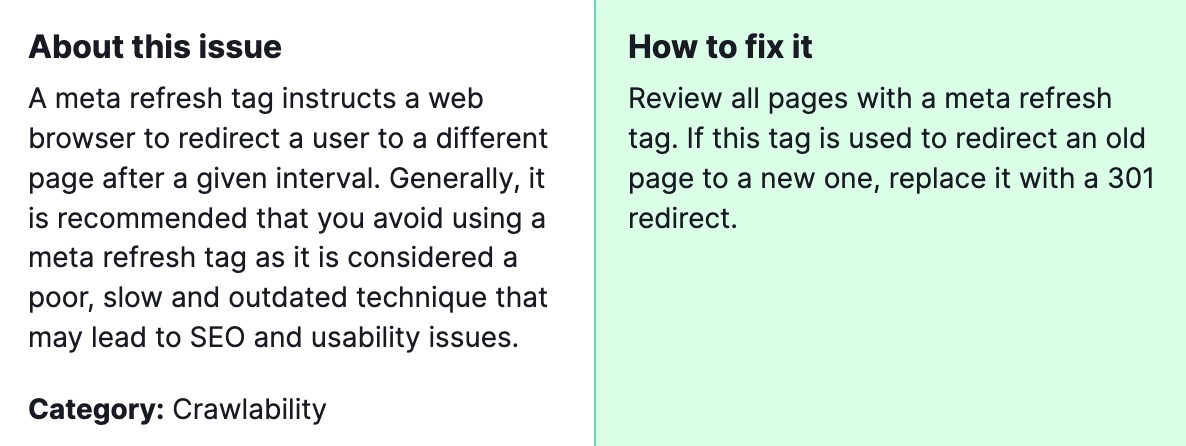When conducting a website audit using SEMrush or any other SEO tool, encountering the issue of “Pages have a meta refresh tag” can be a significant finding. Meta refresh tags are used to automatically redirect a user from one page to another after a specified number of seconds. Although they can be useful in certain contexts, like redirecting from an old URL to a new one, they are generally discouraged for several reasons. They can disorient users, are not favored by search engines, and can hinder the performance of your site in search engine results pages (SERPs).
Fixing the “Pages have a meta refresh tag” issue is essential for:
- SEO Improvement: Meta refresh tags can hinder search engine crawling and indexing, potentially affecting your site’s visibility in search results.
- User Experience: These tags can disorient users with unexpected page redirects, leading to a poor user experience.
- Efficiency: Redirects via meta refresh tags are slower than server-side redirects (like 301s), impacting page load time and overall site performance.
Addressing this issue leads to better SEO rankings, improved user satisfaction, and a more efficient website.
How to fix the Semrush Site Audit Warning of “Pages have a meta refresh tag”?

Here are the steps you can take to fix the issue in a way that benefits both users and search engines:
1) Identify the Pages with Meta Refresh Tags
The first step is to identify which pages on your website are using meta refresh tags. Your SEMrush audit report should provide you with a list of these pages. Make a comprehensive list of all affected URLs for your reference.
2) Evaluate the Need for Redirection
For each page that uses a meta refresh tag, evaluate if the redirection is necessary. Ask yourself:
- Is this redirection serving a valuable purpose for the user?
- Could the content be merged into one page instead of redirecting?
- Is there a more SEO-friendly way to achieve the same goal?
3) Use 301 Redirects
If you decide that redirection is necessary, the best practice is to use a 301 redirect instead of a meta refresh tag. A 301 redirect is a permanent redirect that passes most of the link equity (ranking power) to the redirected page. You can implement 301 redirects via your website’s .htaccess file on an Apache server, or the web.config file on a Windows server. This approach is much more SEO-friendly and preserves the user experience.
4) Update Internal Links
After implementing 301 redirects, ensure that all internal links pointing to the old URLs are updated to point directly to the new URLs. This step reduces the reliance on redirects, improves page load time, and enhances the user experience.
5) Monitor the Changes
Once the changes have been made, monitor your website’s performance closely. Use tools like Google Analytics and Google Search Console to keep an eye on traffic patterns, user behavior, and any crawl errors that might arise. Additionally, consider running another audit through SEMrush after making these changes to ensure that the issue has been fully resolved.
6) Communicate with Users
If the redirections significantly alter how users interact with your site, consider communicating these changes through your website or via email newsletters. This transparency can help manage user expectations and maintain a positive user experience.
If the suggested solutions don’t resolve your issue, please reach out to our team for further assistance.




